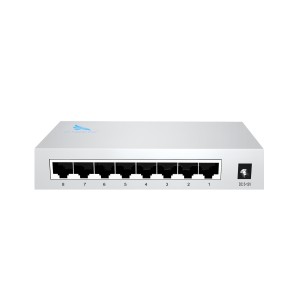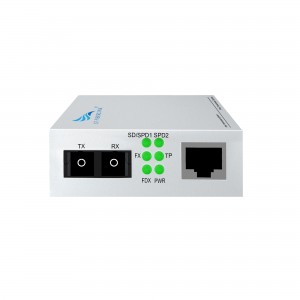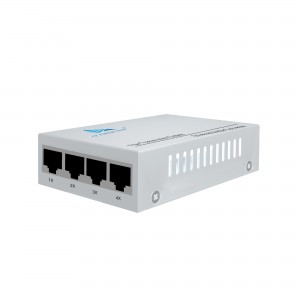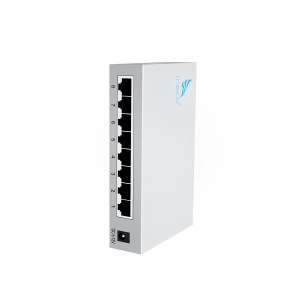5-port 10/100M WDM Media Converter (Single-mode Single-fiber SC)
5-port 10/100M WDM Media Converter (Single-mode Single-fiber SC)
Product Features:
Introducing the SFP to RJ45 Converter, the ultimate solution for seamless and efficient data transmission. Developed by Huizhou Changfei Optoelectronics Technology Co., Ltd., a leading manufacturer in the field of industrial intelligent network managed switches, this fiber optic transceiver is designed to meet the needs of modern network environments.
The converter adopts 1-optical 4-electrical single-mode single-fiber B-side configuration, which bridges the gap between SFP and RJ45 interfaces, making it ideal for various applications. Whether you need to connect fiber optics to Ethernet equipment or vice versa, this converter has you covered. Its versatility allows easy integration into existing network systems, ensuring uninterrupted connectivity.
The converter has an SC interface, which can provide a stable and reliable connection between devices. SC interface is widely adopted due to its low insertion loss and high return loss, ensuring excellent signal quality and reducing potential data interruption.
Navigating complex networks has never been easier with the converter’s dynamic LED indicators. LED lights indicate the status of power, link, and activity, providing a visual aid for monitoring network performance. This feature enables users to quickly identify and resolve any connectivity issues, saving valuable time and resources.
One of the outstanding features of this converter is its simplicity. With a plug-and-play design, users can easily set up and use the device without additional tools or technical expertise. A streamlined installation process ensures a hassle-free experience, eliminating any unnecessary complications.
Huizhou Changfei Optoelectronics Technology Co., Ltd. knows the importance of reliable and efficient data transmission in today’s fast-paced world. That’s why this converter has been engineered to provide excellent performance and reliability. With a commitment to quality and customer satisfaction, the company has earned a solid reputation for producing cutting-edge networking solutions.
In conclusion, Huizhou Changfei Optoelectronics Technology Co., Ltd.’s SFP to RJ45 Converter is perfect for seamless and hassle-free data transfer. Its 1 optical, 4 electrical, single-mode single-fiber B-end configuration, combined with the humanized plug-and-play design, ensures easy integration into any network environment. Featuring an SC interface and dynamic LED indicators, the converter provides excellent performance and ease of use. I believe that Huizhou Changfei Photoelectric Technology Co., Ltd. will provide you with innovative network solutions that meet your needs. Upgrade your network connection today with an SFP to RJ45 converter.
What This Product Does
◇ CF-1014SW-20B is a Hundred megabytes media converter, providing a Hundred megabytes RJ-45 port and a Hundred megabytes SC fiber port, which can convert between electrical and optical signals.
How This Product Works
◇ CF-1014SW-20B adopts WDM (wavelength division multiplexing) technology, helping send and receive data at a distance of up to 20 km with only a single mode fiber, which saves half of the cable deployment cost for customers. CF-1014SW-20B transmits data at 1550 nm wavelength and receives data at 1310 nm wavelength on optical fiber. Therefore, the terminal device used in conjunction with the CF-1014SW-20B should send data at a wavelength of 1310 nm and receive data at a wavelength of 1550 nm. CF FIBERLINK another media converter CF-1014SW-20A is one of the products that can cooperate with CF-1014SW-20B.
Other Features
◇ In addition, the media converter can be used as a standalone device for automatic MDI/MDI-X in the TX port, where duplex mode is automatically negotiated.
technical parameter:
| Model | CF-1014SW-20B | |
| Interface Characteristics | ||
| Fixed Port | 4* 10/ 100Base-TX RJ45 port
1* 155M uplink SC fiber port |
|
| Ethernet Port | 10/ 100Base-TX auto-sensing, full/half duplex MDI/MDI-X self-adaption | |
| Twisted Pair
Transmission |
10BASE-T: Cat3,4,5 UTP(≤100 meter)
100BASE-T: Cat5e or later UTP(≤100 meter) |
|
| Optical Port | Default optical module is single-mode single-fiber 20km, SC port | |
| Wavelength/Distance | A-end: RX1310nm / RX1550nm 0 ~ 40KMB-end:RX1550nm/ RX1310nm 0 ~ 40KM | |
| A-end: RX1490nm / RX1550nm 0 ~ 120KMB-end:RX1550nm/ RX1490nm 0 ~ 120KM | ||
| Chip Parameter | ||
| Network Protocol | IEEE802.3 10BASE-T, IEEE802.3i 10Base-T,IEEE802.3u 100Base-TX, IEEE802.3u 100Base-FX, IEEE802.3x | |
| Forwarding Mode | Store and Forward(Full Wire Speed) | |
| Switching Capacity | 1Gbps | |
| Buffer Memory | 0.744Mpps | |
| MAC | 1K | |
| LED Indicator | Fiber | SD/SPD1 (green) |
| rate | SPD2: 10/ 100 (green) | |
| Data | FX(green)/TP (green) | |
| FDX (green) | ||
| Single / duplex | ||
| Power | PWR (green) | |
| Power | ||
| Working Voltage | AC:100-240V | |
| Power Consumption | Standby<1W, Full load<4W | |
| Power Supply | DC:5V/2A industrial power supply | |
| Lightning protection &Certification | ||
| Lightning protection | Lightning protection: 4KV 8/20us, Protection level: IP30 | |
| Certification | CCC;CE mark, commercial; CE/LVD EN60950;FCC Part 15 Class B; RoHS | |
| Physical Parameter | ||
| Operation TEMP | -20~+55°C;5%~90% RH Non condensing | |
| Storage TEMP | -40~+85°C;5%~95% RH Non condensing | |
| Dimension (L*W*H) | 94mm* 71mm*27mm | |
| Installation | Desktop, CF-2U14 slot rack | |
Product Size:
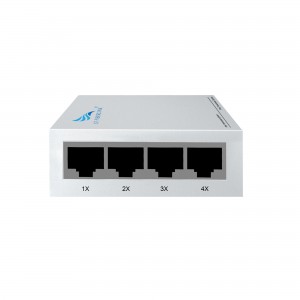
Product application diagra:

How to choose a fiber optic transceiver?
Optical fiber transceivers break the 100-meter limitation of Ethernet cables in data transmission. Relying on high-performance switching chips and large-capacity caches, while truly achieving non-blocking transmission and switching performance, they also provide balanced traffic, isolation and conflict. Error detection and other functions ensure high security and stability during data transmission. Therefore, fiber optic transceiver products will still be an indispensable part of actual network construction for a long time. So, how should we choose fiber optic transceivers?
1. Port function test
Mainly test whether each port can work normally in the duplex state of 10Mbps, 100Mbps and half-duplex state. At the same time, it should be tested whether each port can automatically select the highest transmission speed and automatically match the transmission rate of other devices. This test can be included in other tests.
2. Compatibility test
It mainly tests the connection ability between the optical fiber transceiver and other devices compatible with Ethernet and Fast Ethernet (including network card, HUB, Switch, optical network card, and optical switch). The requirement must be able to support the connection of compatible products.
3. Cable connection characteristics
Test the fiber optic transceiver’s ability to support network cables. First, test the connection ability of Category 5 network cables with lengths of 100m and 10m, and test the connection ability of long Category 5 network cables (120m) of different brands. During the test, the optical port of the transceiver is required to have a connection capability of 10Mbps and a rate of 100Mbps, and the highest must be able to connect to a full-duplex 100Mbps without transmission errors. Category 3 twisted pair cables may not be tested. Subtests can be included in other tests.
4. Transmission characteristics (transmission loss rate of data packets of different lengths, transmission speed)
It mainly tests the packet loss rate when the optical fiber transceiver optical port transmits different data packets, and the connection speed under different connection rates. For the packet loss rate, you can use the test software provided by the network card to test the packet loss rate when the packet size is 64, 512, 1518, 128 (optional) and 1000 (optional) bytes under different connection rates. , the number of packet errors, the number of packets sent and received must be more than 2,000,000. Test transmission speed can use perform3, ping and other software.
5. The compatibility of the whole machine to the transmission network protocol
It mainly tests the compatibility of fiber optic transceivers to network protocols, which can be tested in Novell, Windows and other environments. The following low-level network protocols such as TCP/IP, IPX, NETBIOS, DHCP, etc. must be tested, and the protocols that need to be broadcast must be tested. Optical transceivers are required to support these protocols (VLAN, QOS, COS, etc.).
6. Indicator status test
Test whether the status of the indicator light is consistent with the description of the panel and the user manual, and whether it is consistent with the current status of the fiber optic transceiver.









